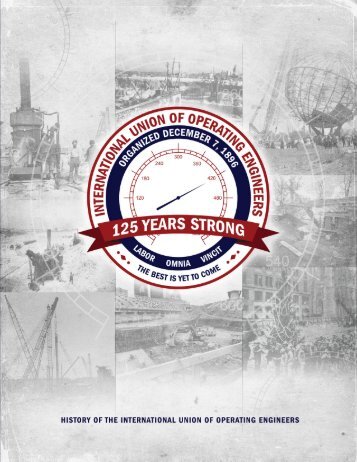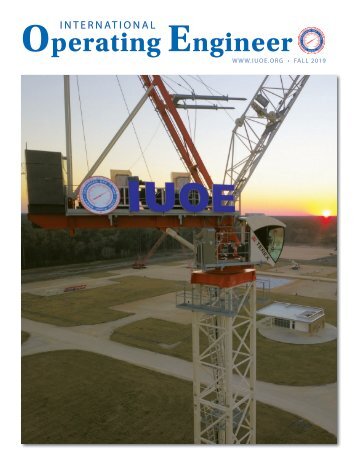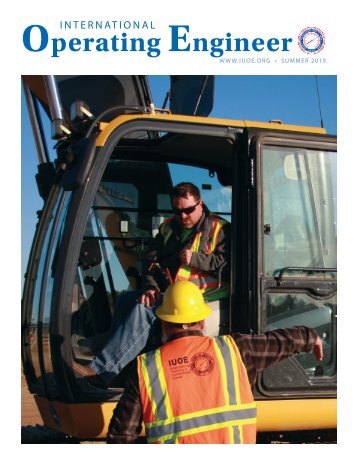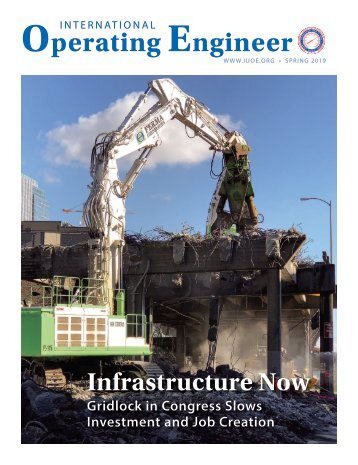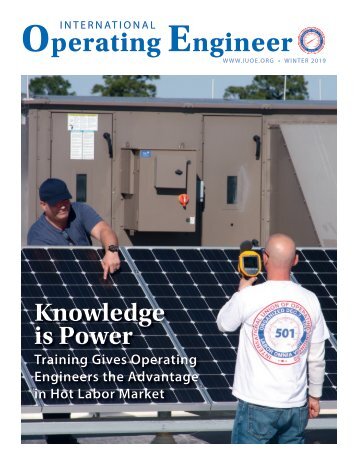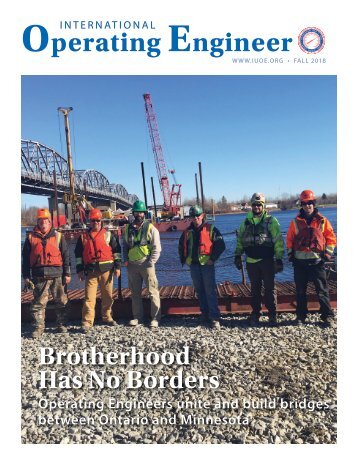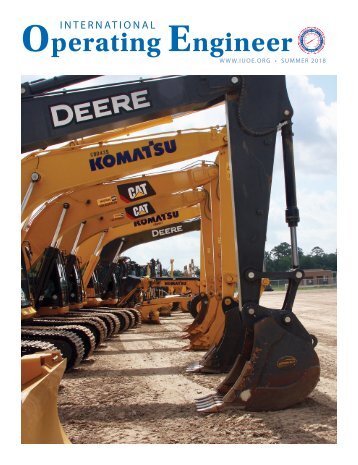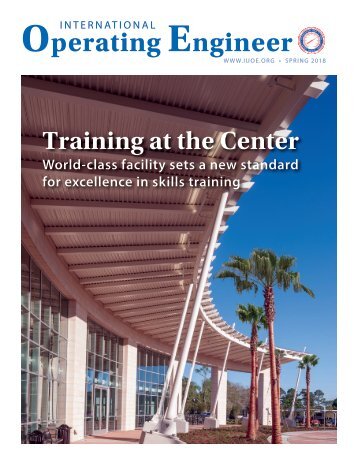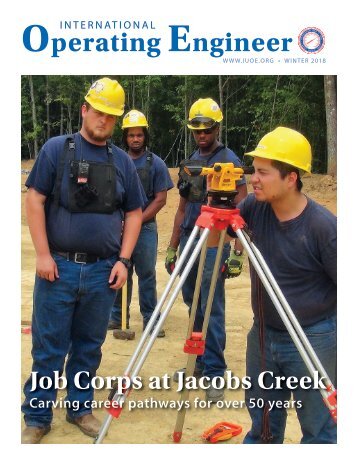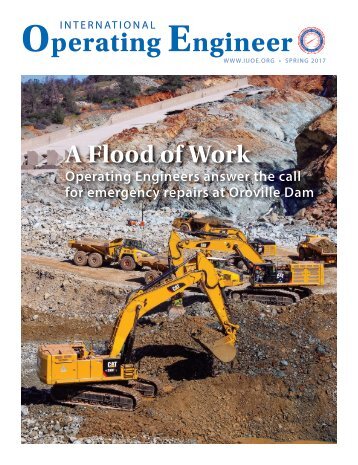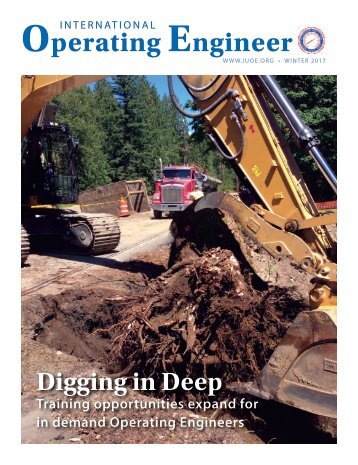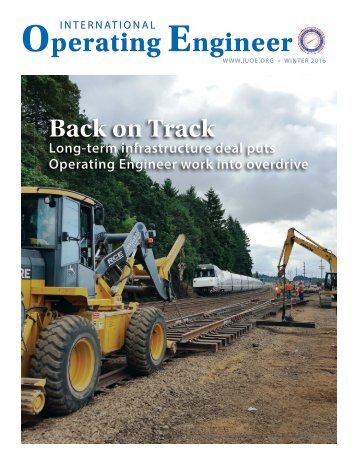125 Years Strong – An IUOE History
- Text
- Wwwiuoeorg
- Vincit
- Omnia
- Engineer
- Convention
- Membership
- Locals
- Operating
- Engineers
INTERNATIONAL UNION OF
INTERNATIONAL UNION OF OPERATING ENGINEERS local unions into its fold beginning in 1902 and 1903 under General President Patrick McMahon. Through his leadership, the union then put its largest amount of resources toward organizing to date in 1904, during which it had five organizers in the field and made targeted efforts to organize in Illinois, Indiana, Ohio, Pennsylvania, New York, Wisconsin, Minnesota, Missouri and Kentucky. As a result, the union’s membership doubled between its conventions that year and in 1905. But the union’s international organizers were often diverted from their primary duties in order to settle issues its locals were having with other locals, their employers or other unions. Ultimately, despite the heavy expenditures of time and money, the results of the union’s organizing campaigns were disappointing, as General President John E. Bruner, who took over leadership of the union following Brother McMahon’s death on June 23, 1904, reported to the delegates of the I.U.S.E.’s Eighth Annual Convention in Omaha, Nebraska, on September 12, 1904: “While the growth of our Organization has not been as great in the year 1904 as it was in 1903, still our progress has been of a healthy nature; many of the locals secured in the year of 1903 needed careful attention and assistance to maintain their standing. The work of our organizers has not borne the results anticipated, not because of lack of energy injected into the movement, but antagonism from many manufacturers' associations, Parryites and other Engineers’ associations organized as a mutual admiration society. The organizers were also called upon to do a large amount of work, on calls for general officers, to assist locals in settling disputes with employers and otherwise.” Perhaps restricting organizing efforts even more was the international union’s weak financial status, propagated by many locals’ determination to retain a measure of independence by limiting funding to the international office, which impeded the union’s I.U.O.E. HEA For the first nearly 18 years after being established in December 1896, the National Union of Steam Engineers and its re-named successors, the International Union of Steam Engineers (I.U.S.E.) and the International Union of Steam and Operating Engineers (I.U.S.O.E.) – each a predecessor to the I.U.O.E. – did not have a central, established office location. Instead, the union’s headquarters were considered to be wherever its general president or general secretarytreasurer were located; for instance, in 1900, the I.U.S.E. was headquartered in Kansas City, Kansas, as General Secretary Samuel L. Bennett lived there (while General President Philip A. Peregrine lived and worked in Denver). During his administration beginning in September 1905, I.U.S.E./I.U.S.O.E. General President Matthew Comerford first had his headquarters in St. Paul, Minnesota, which was his hometown and the location of his home local, No. 36. In early 1907, Brother Comerford relocated his office and, therefore, those of the international union to New York City, occupying various locations around Brooklyn before setting up offices in mid-1909 in the borough’s Temple Bar Building (into which publishing of the union’s journal, The International Steam Engineer, was also moved at that time), which would serve as headquarters for the next five years. The Temple Bar Building at 44 Court Street in Brooklyn, New York, in which the I.U.O.E. headquartered its offices from 1909 into 1913. (Photography © New York Historical Society, George P. Hall & Son Photograph Collection, PR 024, nyhs_PR024_b-19_f-173_008-01.) DQUARTERS LOCATIONS The former residence at 6334 Yale Avenue in Chicago, shown in 1914, that served as I.U.O.E. headquarters from 1913 into 1929. While dealing with the confusion, delays and unnecessary correspondence caused by the lack of a permanent headquarters, the general officers regularly requested the union establish a central location for its offices. Ultimately, during the I.U.S.O.E. 1912 convention in St. Paul, delegates granted the General Executive Board the authority to select a city in which to establish a general headquarters and to spend the necessary funds to purchase it. The board considered New York, Washington and St. Paul before finally selecting Chicago and soon after purchasing a former residence there at 6334 Yale Avenue. On May 1, 1913, the union took possession of the building, about which the April 1913 issue of the union’s International Steam Engineer journal reported, “The house is in excellent repair and will be ample for headquarters for the International Union of Steam and Operating Engineers for 25 years to come.” After just 16 years, the growing I.U.O.E. needed a larger office that was closer to the legislative epicenter of the country. It subsequently moved its international headquarters in 1929 into the Carpenters Union Building at 1003 K Street in Washington, D.C., where it would remain for the next 27 years. By that time, the I.U.O.E. had begun construction on April 8, 1955, on a new headquarters building of its own on a site at 1125 17 th Street, N.W., in downtown Washington, which it had purchased in the summer of 1954. In late 1956, the union moved its expanding offices into the modern, six-story facility constructed of structural steel and reinforced concrete that it built at a cost of ,135,900. Three decades later, the I.U.O.E. completely renovated its headquarters building over a two-year period before rededicating it in July 1998 with a ceremony attended by more than 200 international and local union officials, guests and staff. The refurbishment project completely made over the exterior and interior of the facility with new sidewalks and decks; a modern façade; reconfigured and modernized offices; a new hightech, modem boardroom; and the most-technologically advanced and efficient systems that control heating, cooling and wiring. The current I.U.O.E. headquarters building at 1125 17 th Street, N.W., in Washington, D.C., under construction in 1956. I.U.O.E. H.Q. & OFFICES Various Locations across U.S. 1896 – 1909 Temple Bar Building 44 Court Street, Brooklyn, N.Y. 1909 – 1913 I.U.S.O.E./I.U.O.E. Building 6334 Yale Avenue, Chicago 1913 – 1929 Carpenters Union Building 1003 K Street, N.W., Washington, D.C. 1929 – 1956 I.U.O.E. Building 1125 17 th Street, N.W., Washington, D.C. 1956 – present LABOR OMNIA VINCIT WORK CONQUERS ALL
- Page 2: LABOR OMNIA VINCIT WORK CONQUERS AL
- Page 6: INTERNATIONAL UNION OF OPERATING EN
- Page 10: INTERNATIONAL UNION OF OPERATING EN
- Page 16: INTERNATIONAL UNION OF OPERATING EN
- Page 20: INTERNATIONAL UNION OF OPERATING EN
- Page 24: INTERNATIONAL UNION OF OPERATING EN
- Page 28: INTERNATIONAL UNION OF OPERATING EN
- Page 32: INTERNATIONAL UNION OF OPERATING EN
- Page 36: INTERNATIONAL UNION OF OPERATING EN
- Page 40: INTERNATIONAL UNION OF OPERATING EN
- Page 44: INTERNATIONAL UNION OF OPERATING EN
- Page 48: INTERNATIONAL UNION OF OPERATING EN
- Page 52: INTERNATIONAL UNION OF OPERATING EN
- Page 56: INTERNATIONAL UNION OF OPERATING EN
- Page 60: INTERNATIONAL UNION OF OPERATING EN
- Page 64:
INTERNATIONAL UNION OF OPERATING EN
- Page 68:
INTERNATIONAL UNION OF OPERATING EN
- Page 72:
INTERNATIONAL UNION OF OPERATING EN
- Page 76:
INTERNATIONAL UNION OF OPERATING EN
- Page 80:
INTERNATIONAL UNION OF OPERATING EN
- Page 84:
INTERNATIONAL UNION OF OPERATING EN
- Page 88:
INTERNATIONAL UNION OF OPERATING EN
- Page 92:
INTERNATIONAL UNION OF OPERATING EN
- Page 96:
INTERNATIONAL UNION OF OPERATING EN
- Page 100:
INTERNATIONAL UNION OF OPERATING EN
- Page 104:
INTERNATIONAL UNION OF OPERATING EN
- Page 108:
INTERNATIONAL UNION OF OPERATING EN
- Page 112:
INTERNATIONAL UNION OF OPERATING EN
- Page 116:
INTERNATIONAL UNION OF OPERATING EN
- Page 120:
INTERNATIONAL UNION OF OPERATING EN
- Page 124:
INTERNATIONAL UNION OF OPERATING EN
Inappropriate
Loading...
Mail this publication
Loading...
Embed
Loading...
International Operating Engineer
HEADQUARTERS
INTERNATIONAL UNION OF OPERATING ENGINEERS (IUOE)
1125 17th Street, NW
Washington, DC 20036
202 429-9100
CONTACT US
Send us an email here.
©2010 International Union of Operating Engineers. All Rights Reserved.|Terms Of Use|Privacy Statement|Sitemap

